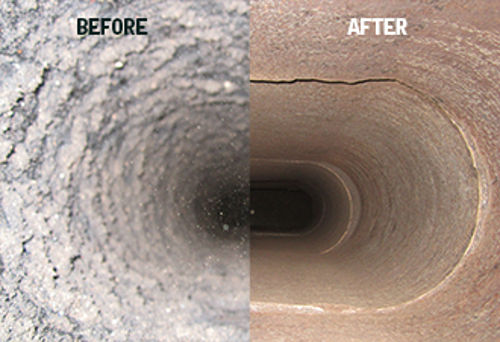Chimney

Chimneys are ventilation channels that guide smoke and other gases that are products of combustion out from a fireplace through the roof of a building. Chimneys operate based on the principle that hot air is less dense than cold air, and thus rises. When a chimney is filled with hot smoke or other gases, these gases rise up through the chimney. The hot, rising gas creates a pressure difference known as a draft which pulls combustion gases out of the building.[2]
Chimneys must be able to protect the structure of the home from the hot gases that pass through it, as well as being able to resist the high temperatures that could result from a chimney fire. On the outside chimneys must be able to resist weather effects and must be sealed to prevent leakage.[2] Chimneys are essentially enclosed columns of warm air surrounded by colder outside air. When chimneys are not in use, they can allow cold backdraft back into the home since the house is full of warm air. The warm air can then leave the house through the chimney through the same process of rising that hot smoke does when wood is being burned. To prevent this, insulation of the chimney is important along with closing the flue when not in use.[2]
Types
Although chimneys all perform the same function, they can differ slightly in their construction. The basic types of chimney are:[2]
- Factory-built metal: These can be used with wood-burning appliances, and have a cap installed to prevent water from leaking into the insulation around the chimney. These are generally composed of a high temperature metal and are used with some central heating furnaces.
- Masonry: These chimneys must be built to strict codes and can be used with wood-burning appliances. This type of chimney is composed of a clay tile liner surrounded by brick or stone. Stainless steel liners can be installed or used to correct internal damage in an existing chimney. Conventional masonry chimneys have no insulation and if not built properly can pose serious issues in terms of allowing cold into the home or heat out. These chimneys can be insulated if cold becomes an issue.
Improving Efficiency
Improving the efficiency of the fireplace and chimney can reduce heat loss from the chimney, making it operate better during the cold months. Some simple ways to improve the efficiency of your fireplace and chimney include:[3]
- Keeping the fireplace damper closed to prevent warm air from rising up the chimney instead of heating the home.
- Seal chimneys if the fireplace is never used to improve how air-tight the home is.
- Check the seal between the fireplace flue damper and the chimney to ensure no cold air enters and no warm air leaves the fireplace when in operation.
- Add caulking around the fireplace hearth to keep heat in.
Chimneys must also be inspected inside and out regularly to ensure that they are operating as well as they can. One thing that must be looked for carefully is cracks in the chimney, as these could allow smoke to enter the home or expose parts of the chimney to high temperatures that could cause a fire. Repairing cracks helps to ensure that the home is as efficient as possible and prevents warm or cold air to leave or enter the building.[4]
Safety

If chimneys are not cleaned regularly, buildup of a tar like substance called "creosote" can become an issue and the risk of fire increases.[6] When wood is burned and makes a smoky fire, the smoke can condense inside of the chimney creating creosote, which is highly flammable.[6] This creosote can ignite, creating an extremely hot temperature damaging the inside of the chimney and potentially igniting the rest of the house. Chimneys should be inspected regularly, especially during the spring and fall seasons, and if significant amounts of buildup exist it should be cleaned immediately.[2]
For Further Reading
- Smokestack
- Home heating
- HVAC
- Hydrocarbon combustion
- Or explore a random page
References
- ↑ Wikimedia Commons. (May 25, 2015). Chimney 5166 ub [Online]. Available: http://commons.wikimedia.org/wiki/File:Chimney_5166_ubt.JPG#/media/File:Chimney_5166_ubt.JPG
- ↑ 2.0 2.1 2.2 2.3 2.4 Wood and Heat Organization. (May 25, 2015). How Chimneys Work [Online]. Available: http://www.woodheat.org/how-chimneys-work.html
- ↑ Energy.gov. (May 25, 2015). Fall and Winter Energy-Saving Tips [Online]. Available: http://energy.gov/energysaver/articles/fall-and-winter-energy-saving-tips
- ↑ US Environmental Protection Agency. (May 25, 2015). Consumers - Energy Efficiency and Wood-Burning Stoves and Fireplaces [Online]. Available: http://www.epa.gov/burnwise/energyefficiency.html
- ↑ This image was taken from https://wellssons.com/cleaning-creosote-from-your-chimney-3/ on June 1st, 2018.
- ↑ 6.0 6.1 NFPA Journal, January/February 2012 By John R. Hall, Jr., available online at: https://www.nfpa.org/News-and-Research/Publications/NFPA-Journal/2012/January-February-2012/News-and-Analysis/Fire-Analysis-and-Research Accessed June 1st, 2018.

